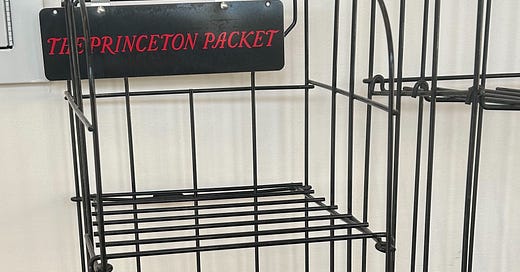TBT: News Deserts and the Demise of Journalism
The Announcement that the Star-Ledger Would No Longer Print Is Part of a Long Erosion of the Business
The Star-Ledger will no longer publish a print newspaper.
The news appears to have been a minor blip, only relevant to older readers who grew up with ink-stained fingers from reading the print press and people like me, who have spent the better part of their adult lives as reporters, editors, or teachers of journalism.
I was an accidental journalist. I did some sports writing in high school, thought about becoming a journalist when I went off to college, became a business major for a time and then dropped out. I was writing a lot, having discovered a love of Beat literature and poetry. I saw myself as a writer, a poet, an artist, returned to school as an English major, spent a year in graduate school before leaving that behind.
I was working part-time at the Burrito Royale, a local taco joint, when one of our regulars told me she was a freelance writer for the local paper. She connected me with the sports editor and I did some freelance work — high school wrestling and girls basketball, some baseball. This led to covering the school board, then a part-time position with the paper, which turned into a full-time gig that lasted 20 years before I left to help launch a half-dozen news websites with Patch.
My 20 years with the Princeton Packet chain, 15 of which were as an editor, gave me a front-row seat to both the importance of local news and to the crisis that print journalism was facing. We broke numerous stories and won many awards — including being named the state’s best small weekly. At the same time, I watched as the chain did what all papers were doing — racking up debt and, ultimately, being forced by the banks that held the debt to cut costs. We went from about 75 editorial employees at 13 papers to about 20 when I left — and fewer and fewer over the next five years as individual papers were closed and what was left was sold off.
What happened to The Packet happened to Patch, and has been happening to papers across the country for years as big newspaper chains swoop in and buy regional dailies and rich entrepreneurs buy the big papers pretending that their business acumen means they understand how media works.
They don’t, as Jeff Bezos’ strong-arming The Washington Post editorial board into not endorsing should make clear.
The announcement yesterday that Newark Morning Leader Co. and Advance Local (the companies that ran the former Ledger empire) would be shuttering what’s left of their New Jersey print publications and shutting its printing plants should not shock anyone.
The Star-Ledger will cease publishing a print newspaper and will close its Montville production facility in February 2025. The decision was made by the Star-Ledger’s owner, Newark Morning Ledger Co., due to rising costs, decreasing circulation and reduced demand for print.
In addition, Advance Local, which owns NJ Advance Media and NJ.com, announced that it is ending print publication of dailies The Times of Trenton and the South Jersey Times, as well as the weekly Hunterdon County Democrat.
The announcement added that the online versions of the The Star-Ledger, The Times of Trenton and South Jersey Times “will continue to be produced seven days a week for subscribers,” which makes some sense given where readers are, even if the ad models that fund news in 2024 remain in flux and digital has not proven to be the boon some expected.
But the Ledger was once among the 50 largest papers in the country by circulation. It was central to news coverage in New Jersey, a kind of state-level version of The New York Times, a must read if you had any interest in what was happening in the Statehouse.
And yet, it was no more immune to changes in the news environment than other large regional dailies (and smaller papers0, to the changes driven only partly by technology and that date back to the ‘50s and ‘60s when consolidation of big city papers masked a fall off in readers and the remaining big papers started chasing the suburbs. The Ledger — born of a merger of two Newark papers — was a fairly representative example of print journalism, using its size and reach to generate ad revenue and make its owners money.
It’s important to remember the model followed by print in the pre-TV age. Papers were constructed to be all things to all people, because they often owned a monopoly on information within their geographic region. Papers like the Ledger offered everything from comics and puzzles to the best sports coverage in New Jersey, fashion and food reporting, and news coverage that ranged from the hyperlocal to the national. It also was the only place for local businesses to advertise. This funded their entire operations, allowing them to charge only pennies for subscriptions or at the newsstand.
Television, radio, and direct mail chipped away at the monopoly, offering businesses in particular a new way to reach consumers, which was happening at the same time that chain stores were erasing the traditional mom-and-pop stores that were local papers’ brand and butter. The industry underwent a major contraction during the 1960s as multi-paper cities saw many of their papers close — New York went from seven to three dailies, for instance. The overall readership of print continued to rise with the population, but cable news and the internet began to eat away these gains.
The result has been a series of news-industry layoffs and newspaper closings, which in turn has created a vacuum of information. Local and regional papers have traditionally driven television coverage and serve as the raw material for online news. The loss of reporting jobs and outlets willing to publish original reporting on politics and policy has left outlets like Fox News and worse to dominate the space. The reported and vetted information is getting harder to find, propaganda is growing more prevalent, and misinformation has poisoned our political culture.
The damage is worse at the local level, as I wrote a decade ago, because of the trends I describe above and because of the larger chain-storing of America.
***
Here is my 2013 column on news deserts for The Progressive Populist:
News Deserts
The news this summer that Patch appeared on its last legs was met in the industry with a mix of perverse glee and derision.
The 900-site hyperlocal network owned by AOL, which launched in 2009, had been cutting jobs for more than a year, with repeated changes in its basic structure and focus — changes that seemed more reactive than anything.
So, when word got out that there were more layoffs and even more change, it seemed that Patch’s end was at hand — and its detractors were having a field day.
Among the independent hyperlocal community — the shoe-string sites often housed on WordPress blogs, the press-release factories and the outstanding, single-person operations — Patch was the enemy. It was big and it was corporate, often referred to as the Walmart of hyperlocal websites.
The criticism was both earned — there is a sameness to many of the sites — and incredibly unfair, given the original commitment to quality journalism made by Patch, evident in its initial hiring of more than 1,000 talented journalists.
I worked or Patch for 18 months. I still believe in its mission and think, given the right set of circumstances, the right leadership and a bit of patience from investors, it not only can survive but do well.
Those circumstances do not appear to exist at the moment and, given the uncertainty over the current web-advertising model (no one has figured out how to generate enough revenue from the Web), they may never.
This does not bode well for our democracy — not because Patch is necessary, but because something like Patch is. Having lived through ups and downs with Patch, and having spent 20 years before that working in what I’ll call the hyperlocal print world — a chain of local weekly newspapers covering individual municipalities ranging in population from 3,000 to 50,000 — I know that there are few reliable places for citizens to get information about their local governments or their communities more broadly.
The local newspaper, where it existed, served that role well, though the erosion of print readership and advertising has turned most of them into shells of their former selves.
Michelle Ferrier, associate dean at Scripps College of Communication at Ohio University, is researching what she calls “media deserts” — communities that lack a reliable local news outlet. Since about 2007, she said, about 120 newspapers have closed, eliminating about 33,000 newspaper journalism jobs.
“We are talking about a significant reduction of that work force and brain trust that has been lost,” she said. “How do we measure and get people to understand what has been lost before it is too late, before our newspapers are really just advertising vehicles and no longer providing a critical function of providing fresh news and information to our communities.”
She is mapping newspaper circulation by ZIP Code, along with things like the existence of local news websites, radio and television to the communities that are being hit hardest by the decline of the industry. This will allow her to identify media deserts and, she hopes, to get the discussion started about the impact that these deserts have on people’s ability to “hold meaningful dialoge on issues of critical importance to our communities.”
“What you’re seeing is people are more knowledgeable about what is happening overseas than what is happening on their block,” she said, a view supported by recent surveys from the Pew Research Institute and others.
“There’ve been a slew of reports over the last few years that have said we are losing our capacity to create and disseminate local news,” she said. “As a result, our residents are not engaging in activity that helps support a democratic society.”
They are not attending planning and zoning meetings, where decisions are made on how the properties in the community will be used. They are not attending municipal government meetings, where decisions are made about taxes, services and education.
And, to make matters worse, there are fewer reporters covering these meetings, which makes it even less likely that the information will make it into the community.
“There are more sources – more opportunities for accidental knowledge overseas on Facebook, Twitter, people following stories that are breaking using Twitter and other media,” she said. “There are lots of other places where people can encounter national and international news — TV, radio, their internet browers when they log on.
“But locally, you don’t have that push or visibility,” she said. “Unless you are part of a geographic group on Facebook, you are not going to get that kind of sharing of local news.”
Patch was an integral part of the local news landscape in the communities it served for much of its existence. The jury is still out as to whether it remains a key element of the local news environment or whether, given its recent bumpy history, it can regain its footing.
I am convinced, however, that something like Patch – a network of connected community sites with decent funding behind it – is a necessary part of the mix.
The question we are trying to answer is how you pay for good reporting at the local and state levels. The answer to that question is that we will need a mix of media types – a retooled Patch-like entity, hundreds of feisty independents and a strong group of foundation-funded and non-profit sites – banging up against each other and working together when needed to ensure that the local press fulfill its democratic function.





